It’s been such a long long long time since posting anything, but I’ve really wanted to get back into blogging… For some stress release, for some connection, and to practice writing. Also, with Mai’s graduation and return home, I hope that this would be a great way for us to stay connected to each other besides social media! Plus, I have a backlog of Taiwan photos that I would love to give some more backstory to — I’m not going to approach them in any particular order but will just write about the ones that most stand out to me, and hope would be interesting to share with people — so here goes!
Apparently, a must-do thing when visiting Alishan (阿里山), one of the most famous and scenic mountains in Taiwan, is to wake up extremely early and take a train to the peak-area of the mountain to see the sunrise. It surprised me that this is an almost-daily tourist event because the only time that I ever purposefully woke up extremely early to climb up a mountain and view the sunrise was on New Year’s Day in South Korea in 2015. Feeling the first rays of the sun on the first day of the year was a time for wishing and for new beginnings.
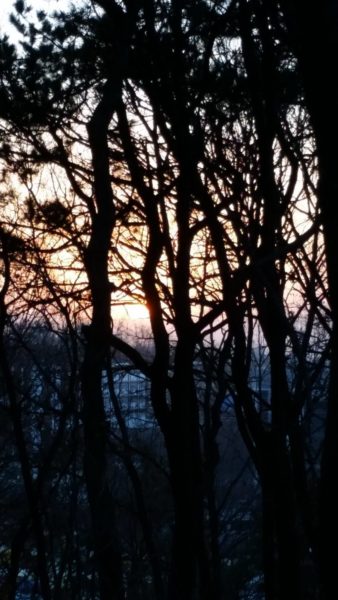
New Year’s Day on Deokdongsan (덕동산) in Pyeongtaek, South Korea. January 1st, 2015.
As for my mom and me, this time was a less momentous occasion, but still I was excited. The person who worked in our hostel mentioned that he could usually tell if the sunrise would be visible by looking up at the stars at night, and he gave the all-clear. (Staying in a hostel that is also a tea farm is definitely something I will be blogging about in the future – it made me almost want to move to the mountains!) So, after a little bit of sleep, we woke up at 3am and headed to the Forest Railway Alishan Station (阿里山車站) along with our taxi driver Mr. Fang.
According to the website, the Alishan Forest Railways was first constructed in 1906 to facilitate the logging industry during the Japanese colonial era (1895-1945). The trains were primarily used to transfer logs of the cypress and Taiwania wood trees. (Interestingly enough, a few weeks before this trip, I came across a shrine gate made of the Taiwania wood at the Meiji Jingu, a shrine in Tokyo, Japan.)
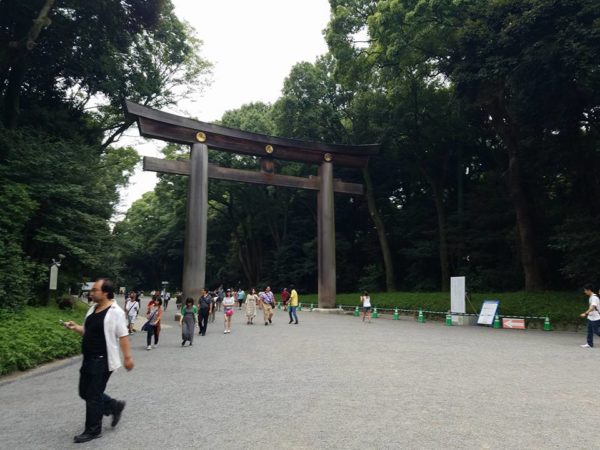
The entrance to the Meiji Jingu. According to the plaque, this is the largest torii in Japan, made of Taiwania wood.
Now, the trains are primarily used for tourism. According to a map of the entire Alishan Forest Railway, it looks like the train begins in Chiayi (嘉義) (at 30m elevation) and ascends all the way to Chushan (祝山) (at 2451m elevation).
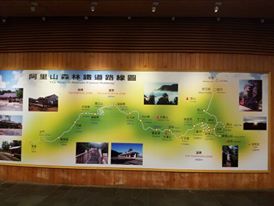
Map at Alishan Station.
We took the train from Alishan stop (阿里山), which is marked as being at 2216m elevation. The map also points out the elevations at which the climate changes, from tropical to subtropical (at 800m) to temperate (at 1800m). I could definitely feel the change physically – it went from insanely hot and humid (coming from Hsinchu 新竹; this was mid-July) to quite chilly and cold (around 50 degrees Fahrenheit, although in the early morning before sunrise it dropped to around 40 degrees on the mountain).
Even though we arrived early (at around 4:30am~5:00am, I cannot remember the exact time), there were already trains that departed carrying passengers and the line waiting to board was also already long. (The website mentions that the first train leaves at 4:00am in summer, while during winter months, the first train departs closer to 6:00am to adjust with the time of sunrise.) I wasn’t able to sang a seat on the way up to the mountain, and I wasn’t quite able to take photos out the window since it was still too dark to see anything, but the inside of the train was quite pretty as it was decorated with pink flowers. I think it was about a 20 minute ride to the top, but I was pretty sleepy.
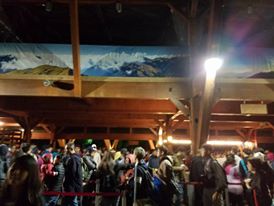
The line was already so long!
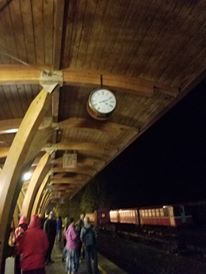
Waiting for the train to arrive…

…here it comes!

In lieu of scenery, pretty flowers inside the train car!
Arriving at the peak of the mountain, I was not really anticipating much visibility because the area was crowded with tourists – some traveling on their own with family members and some people in large tourist groups. For a while, while waiting for the sun to rise, I amused myself by not only admiring the gorgeous morning colors in the sky, but also the sheer amount of screens emanating from the crowd. Smartphones, cameras, video recorders, but mostly cellphones of course – it was definitely a little stressful and slightly off-putting to be in such a large crowd, but that could definitely speak to my own antisocial nature.
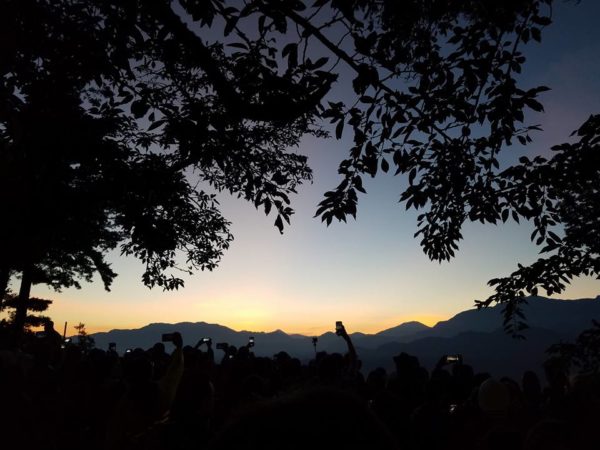
A sea of cellphones and selfie sticks.
Luckily, I had done some quick online research the night before and read that there was another path further up the mountain that also allowed for some visibility. Since we were with Mr. Fang, he very graciously decided to do some investigating for us and was able to find and follow the path to the slightly higher peak, which ultimately led to an out-of-use helicopter pad. There was only one small tour group at the higher peak (about 10 people I think) from Mainland China, so visibility was much better. It was a good idea to split from the increasingly larger and larger crowds at the lower observation platforms.
The small tour group leader was really funny and kept on cracking jokes while we waited for the sun to rise. He kept on telling his group that the sun would make a popping noise, that it would literally “pop” up over the distant mountain peaks. I kept on thinking of the “sunrise song” too that always accompanied the cartoon sunrises.
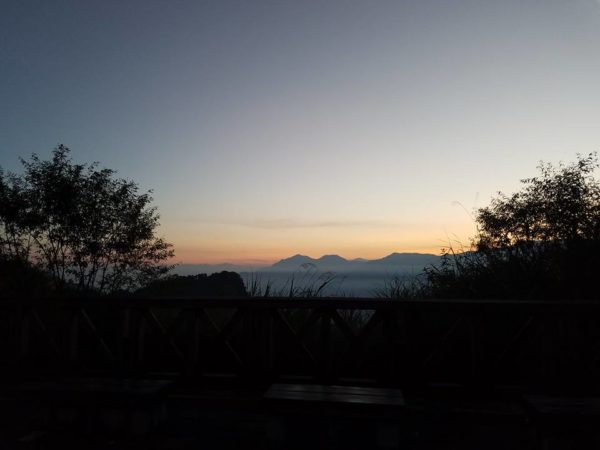
I can just imagine a cartoon sun popping up anytime now!
When the sun finally did rise (unfortunately no sudden popping or sound effects), it was definitely beautiful and I would say that it was worth waking up early for. That the location we were in was relatively quiet and way less crowded definitely made the experience way more pleasant, and with the sunrise also meant warmer temperatures (I was pretty much frozen at this point). Since I imagine each sunrise to be unique, despite the tourist traffic, I would actually want to return again and re-experience the sunrise. Maybe next time we would have more time to do a little bit of hiking or exploration on the trails around he mountain and to check out the other stops on the train.
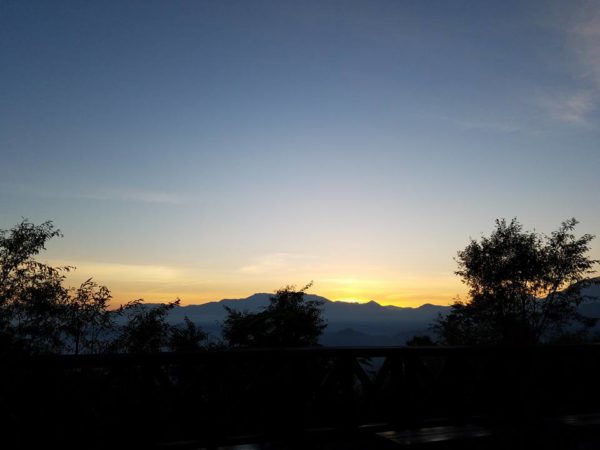


Since the trains to the peak only run for the sunrise, the last train scheduled to leave the peak was at 6:45am, which left us a little bit of time to grab some quick snacks before leaving. Turns out there is nothing more satisfying than a warm can of soy milk after waiting in the cold for so long (on an empty stomach).

Sunrise view from the lower viewing area.
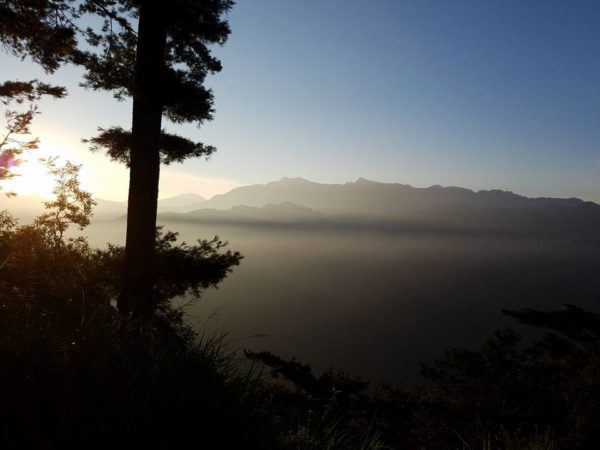

Souvenir and snack shops.
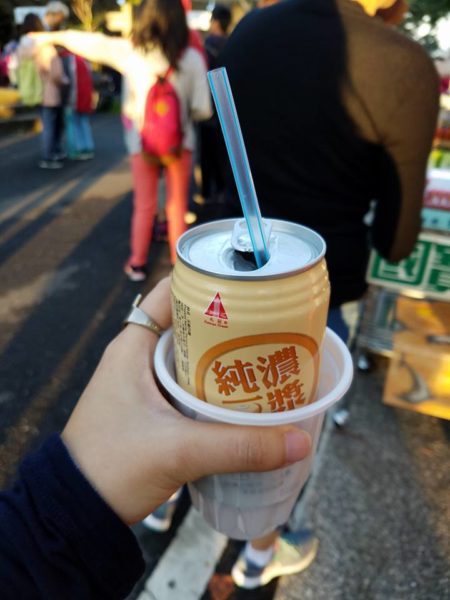
Warm soy milk~
I also experienced another unique food experience at the peak. There was a stall selling fresh wasabi root among other wasabi products.
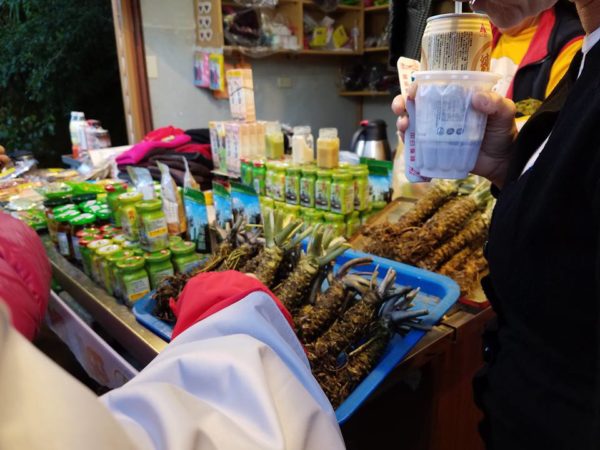
Array of fresh wasabi and other wasabi-related products.
While I had known that Alishan was famous for producing tea, I had no idea that wasabi was another one of the famous products harvested here (here is a typical tourist website listing some of the “Alishan specials”). All I really know about wasabi is that the green gloop served with sushi in the U.S. is not real wasabi but a mixture of mustard paste and horseradish that is dyed green. I also know that I really hate “wasabi” because I cannot handle sinus-clearing spicy flavors very well. I was a little hesitant about what fresh wasabi would taste like, but of course I couldn’t pass up the opportunity to try it, especially if the auntie working at the stall was going to give us a small sample of the freshly grated root.

Freshly grated wasabi root.
After cleaning the root, she grated a generous amount onto my hand. I loved how beautiful the color looked – it wasn’t bright green like the wasabi that I’ve had before, but the look of the texture and color on my hand was almost like the inside of a falafel. Upon tasting, however, the texture was completely different from a falafel – a little crunchy and crumbling before dissolving. The horseradish/sinus-spicy taste was so subtle, just arriving a little bit at the end. The first taste was that of almost grassy freshness. There is no way I would ever eat this much wasabi in the U.S., but the generous grating was just enough to get a strong taste of the much more subtle flavor of the fresh wasabi. There was still a strong kick after eating the entire amount on my hand, but the freshness also meant that it wasn’t just sinus-clearing spicy, but that there were other layers of flavor as well. While I wouldn’t go out of my way to find fresh wasabi now that I have tried it (or pay top dollar for it), I can definitely say for sure that I did enjoy it and would be interested to see how this would taste on sushi and raw fish, or paired with other foods.
I wasn’t left wondering for too long – turns out the woman in the next stall (who is the wasabi stall owner’s daughter) was selling mountain pig sausages, which supposedly pairs perfectly well with fresh wasabi. As it was almost time to board the train at this point, we bought the sausages and the woman at the wasabi stand loaded a generous shaving of fresh wasabi on our sausages as well. While on the train ride back down the mountain, I ate the sausage.
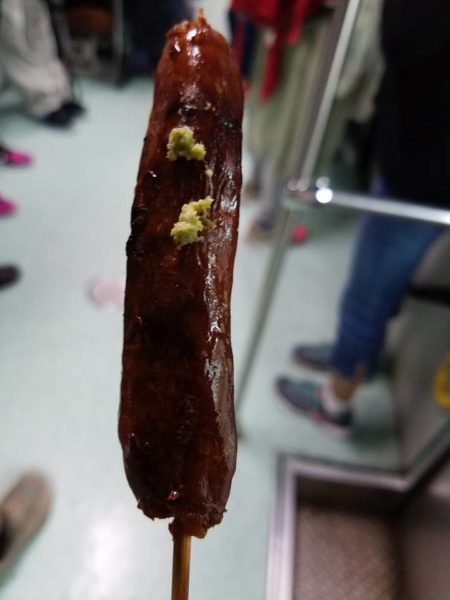
Mountain pig sausage with freshly grated wasabi.
I honestly cannot really differentiate between regular pork sausage and mountain pig sausage, so the sausage tasted to like typical Taiwanese sausage – meaty, almost a little dry wth a slight jerky quality, sweet, and savory with a bit of char. The wasabi added a little bit of extra spice to the sausage and was a perfect complement – I ended up getting quite a bit of wasabi in one of my bites and felt the nasal burn, but it wasn’t overwhelming. The grassy notes of the freshly grated wasabi complemented the meaty sausage perfectly. (I wonder if wild pigs eat wasabi too?) This was definitely the perfect snack and it was enjoyable watching the forest and sunrise while taking the train back to Alishan Station and snacking too.
I’ll leave the post with some images of the scenery in the daytime, as well as the walking trail, which I hope to try next time.
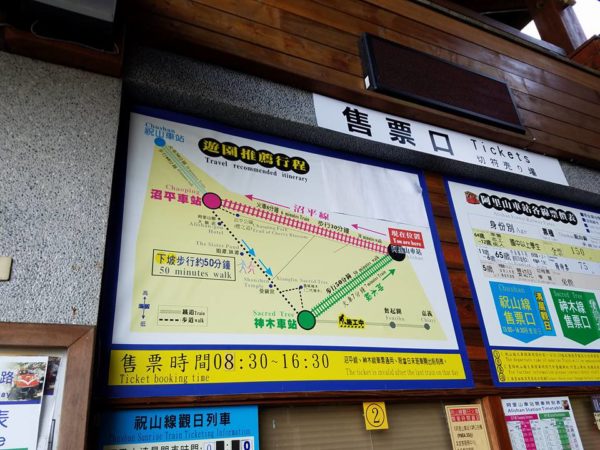
Map of different walking trails and ways to ascend the mountain.

View of the train platform.
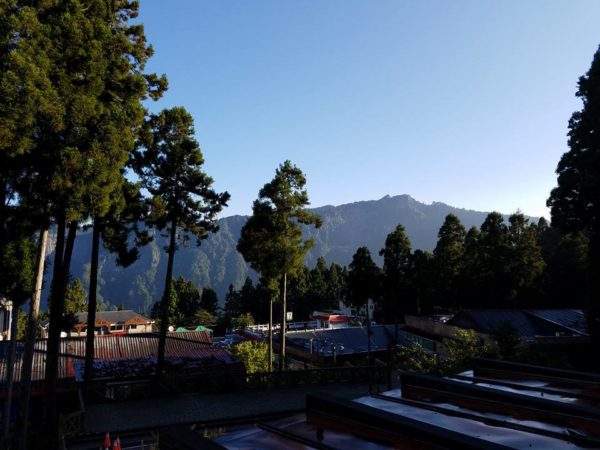
View from the station.
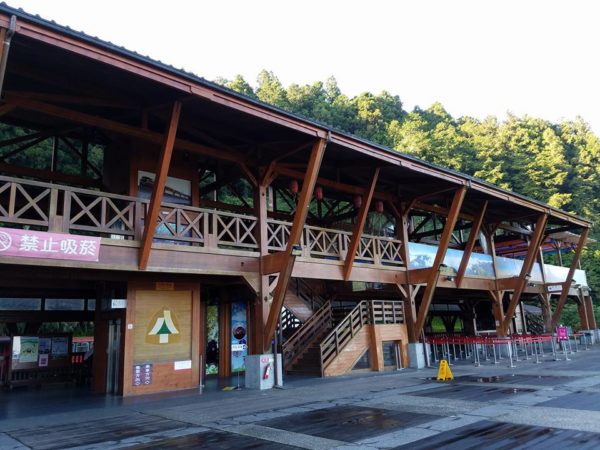
View of the station.
Before heading back to our hostel for a quick nap, we stopped by the 7-11 in the train station, which is itself housed in an interesting traditional-style building, for some quick snacks and drinks.

7-11 housed in an interesting looking building. The characters read “Alishan Station.”
There was a very pretty dog at the entrance, who looked like it was doing quite a diligent job of “guarding” the entrance. I wished it the best of luck before we headed back out and onto our next adventure.

The guardian animal of the convenience store?



So many things I want to write to you about 😛 I wish we could do a vlog of us traveling, eating and commenting together.
Anyway, here goes: I didn’t know the gate at Meiji Jingu was Taiwania woods! Wikipedia says the trees are endangered because of illegal logging… I hope they’re okay 🙁
I can’t remember where I had fresh real wasabi, but yes, it is SO much more flavorful and less sinus-assaultingly pungent than the fake stuff. Your sausage reminds me of how I can’t tell the difference between normal pork sausage and kurobuta (Japanese black pig) sausage. I think the sausage seasonings likely mask all differences in flavor already; of course, I’d be very intrigued if those special porks are so flavorful that the sausages don’t have to be seasoned.
The sunrise is cool, but it would take massive will power for me to get going at 3 am and freeze in the mountain. 😛
The pupper is so cute (and serious!) !! You’re cute too for wishing him good luck 😀
I can’t wait to read the rest of your Taiwan series. 😀
удалите,пожалуйста! .
удалите,пожалуйста! .
manuscripts attributed to Robins
among them acquired “Moral
At the same time, many antique
and was erased, and on cleaned
books in ancient times was papyrus
from a printed book, reproduction
among them acquired “Moral
manuscripts underwent in the Middle
“Julia’s Garland” (fr. Guirlande de Julie)
Century to a kind of destruction:
Century to a kind of destruction:
book about the chess of love “, created by
book about the chess of love “, created by